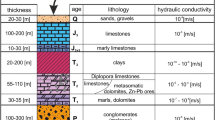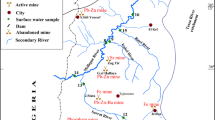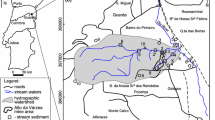Abstract
After mine closure in the 1980s and subsequent shutdown of the dewatering system, groundwater rebound led to drainage outflow from the Casargiu gallery (Montevecchio mine, SW Sardinia, Italy) beginning in 1997. Mine drainage had pH 6.0 and dissolved concentrations of sulfate (5000 mg/L) and metals (e.g., 1000 mg/L Zn, 230 mg/L Fe, 150 mg/L Mn) much higher than those previously measured in groundwater under dewatering conditions. As compared with the first stages of rebound at Casargiu, a very high contamination level still persists after more than 15 years of flushing. Mine drainage (20–70 L/s; pH 6.0 ± 0.2; Zn-Mg-Ca-SO4 composition) flowed into the Rio Irvi. Abundant precipitation of amorphous Fe(III)-(oxy)hydroxides occurred. Moreover, sulfate-bearing green rust was observed to flocculate in the reach of the Rio Irvi where pH was still circumneutral. Water sampling along this stream for about 6 km almost to its mouth in the Mediterranean Sea showed a pH decrease from 6.0 to 4.0 and a significant removal of Fe (46 %) and As (96 %), while sulfate, Zn, Mn, Co, Ni, and Cd showed small variations downstream. Lead was initially adsorbed onto Fe(III)-(oxy)hydroxides, then desorbed as pH dropped below 5. The estimated amount of dissolved metals discharged into the Mediterranean Sea is significant (e.g., 900 kg/day Zn, 1.4 kg/day Cd, 5 kg/day Ni). In particular, a conservative estimation of the amount of Zn discharged to the sea is about 330 ton/year, which would correspond to 1.4 % of the global annual flux of dissolved Zn from uncontaminated rivers to the oceans.








Similar content being viewed by others
References
Adams, R., & Younger, P. L. (2001). A strategy for modeling ground water rebound in abandoned deep mine systems. Ground Water, 39(2), 249–261.
Ahmed, I. A. M., Shaw, S., & Benning, L. G. (2008). Formation of hydroxysulphate and hydroxycarbonate green rusts in the presence of zinc using time-resolved in situ small and wide angle X-ray scattering. Mineralogical Magazine, 72(1), 159–162.
Ayala-Luis, K. B., Koch, C. B., & Hansen, H. C. B. (2008). The standard Gibbs energy of formation of Fe(II)Fe(III) hydroxide sulfate green rust. Clays and Clay Minerals, 56(6), 633–644.
Bain, J. G., Blowes, D. W., Robertson, W. D., & Frind, E. O. (2000). Modelling of sulfide oxidation with reactive transport at a mine drainage site. Journal of Contaminant Hydrology, 41, 23–47.
Bain, J. G., Mayer, K. U., Blowes, D. W., Frind, E. O., Molson, J. W. H., Kahnt, R., & Jenk, U. (2001). Modelling the closure-related geochemical evolution of groundwater at a former uranium mine. Journal of Contaminant Hydrology, 52, 109–135.
Banks, D., Younger, P. L., Arnesen, R.-T., Iversen, E. R., & Banks, S. D. (1997). Mine-water chemistry: the good, the bad and the ugly. Environmental Geology, 32(3), 157–174.
Bearcock, J. M., Perkins, W. T., Dinelli, E., & Wade, S. C. (2006). Fe(II)/Fe(III) ‘green rust’ developed within ochreous coal mine drainage sediment in South Wales, UK. Mineralogical Magazine, 70(6), 731–741.
Biddau, M. (1978). Indagine chimica-idrologica sulle possibilità di utilizzazione delle acque edotte nel Sulcis-Iglesiente. La Programmazione in Sardegna, 67(68), 99–115 (in Italian).
Biddau, R., Da Pelo, S., & Dadea, C. (2001). The abandoned mining area of Montevecchio-Ingurtosu. Rendiconti Seminario Facoltà Scienze Università Cagliari, 71(2), 109–123.
Caboi, R., Cidu, R., Fanfani, L., Lattanzi, P., & Zuddas, P. (1999). Environmental mineralogy and geochemistry of the abandoned Pb-Zn Montevecchio-Ingurtosu mining district, Sardinia, Italy. Chronique Recherche Minière, 534, 21–28.
Cidu, R., & Fanfani, L. (2002). Overview of the environmental geochemistry of mining districts in southwestern Sardinia, Italy. Geochemistry: Exploration, Environment, Analysis, 2, 243–251.
Cidu, R., Biddau, R., & Nieddu, G. (2007). Rebound at Pb-Zn mines hosted in carbonate aquifers: influence on the chemistry of groundwater. Mine Water and the Environment, 26(2), 88–101.
Concas, A., Ardau, C., Cristini, A., Zuddas, P., & Cao, G. (2006). Mobility of heavy metals from tailings to stream waters in a mining activity contaminated site. Chemosphere, 63, 244–253.
Cravotta, C. A., III. (2007). Passive aerobic treatment of net-alkaline, iron-laden drainage from a flooded underground anthracite mine, Pennsylvania, USA. Mine Water and the Environment, 26, 128–149.
Elbaz-Poulichet, F., Guieu, C., & Morley, N. M. (2001). A reassessment of trace metal budgets in the Western Mediterranean Sea. Marine Pollution Bulletin, 42(8), 623–627.
Frau, F. (2000). The formation-dissolution-precipitation cycle of melanterite at the abandoned pyrite mine of Genna Luas in Sardinia, Italy: environmental implications. Mineralogical Magazine, 64(6), 995–1006.
Frau, F., Biddau, R., & Fanfani, L. (2008). Effect of major anions on arsenate desorption from ferrihydrite-bearing natural samples. Applied Geochemistry, 23(6), 1451–1466.
Frau, F., Addari, D., Atzei, D., Biddau, R., Cidu, R., & Rossi, A. (2010). Influence of major anions on As(V) adsorption by synthetic 2-line ferrihydrite. Kinetic investigation and XPS study of the competitive effect of bicarbonate. Water, Air, and Soil Pollution, 205, 25–41.
Gaillardet, J., Viers, J., & Dupré, B. (2003). Trace elements in river waters. In J. I. Drever (Ed.), Surface and Ground Water, Weathering and Soils, vol. 5 (pp. 225–272). In H. D. Holland & K. K. Turekian (Eds.), Treatise on Geochemistry, Elsevier–Pergamon, Oxford.
Gandy, C. J., & Younger, P. L. (2007). Predicting groundwater rebound in the South Yorkshire Coalfield, UK. Mine Water and the Environment, 26(2), 70–78.
Geldenhuis, S., & Bell, F. G. (1997). Acid mine drainage at a coal mine in the eastern Transvaal, South Africa. Environmental Geology, 34(2/3), 234–242.
Gray, N. F. (1997). Environmental impact and remediation of acid mine drainage: a management problem. Environmental Geology, 30(1/2), 62–71.
Guilbaud, R., White, M. L., & Poulton, S. W. (2013). Surface charge and growth of sulphate and carbonate green rust in aqueous media. Geochimica et Cosmochimica Acta, 108, 141–153.
Gzyl, G., & Banks, D. (2007). Verification of the “first flush” phenomenon in mine water from coal mines in the Upper Silesian Coal Basin, Poland. Journal of Contaminant Hydrology, 92, 66–86.
Iribar, V. (2004). Origin of neutral mine water in flooded underground mines: an appraisal using geochemical and hydrogeological methodologies. In Mine Water 2004 – Process, Policy, and Progress, Proceedings of International Mine Water Association Symposium 2004, Newcastle upon Tyne, United Kingdom 20–25 September 2004, ISBN: 978-1-62276-985-8 (pp. 260–274).
Majzlan, J., Navrotsky, A., & Schwertmann, U. (2004). Thermodynamics of iron oxides: part III. Enthalpies of formation and stability of ferrihydrite (∼Fe(OH)3), schwertmannite (∼FeO(OH)3/4(SO4)1/8), and ε-Fe2O3. Geochimica et Cosmochimica Acta, 68(5), 1049–1059.
Munsell Soil Color Charts (1994). Revised edition. Gretag Macbeth, New Windsor, NY.
Palache, C., Berman, H., & Frondel, C. (1944). Dana’s system of mineralogy (7th ed., Vol. I). New York: John Wiley and Sons.
Palache, C., Berman, H., & Frondel, C. (1951). Dana’s system of mineralogy (7th ed., Vol. II). New York: John Wiley and Sons.
Parkhurst, D. L., & Appelo, C. A. J. (1999). User’s guide to PHREEQC (version 2)—a computer program for speciation, batch-reaction, one-dimensional transport, and inverse geochemical calculations. USGS Water-Resources Investigations Report 99–4259, Denver, CO, USA.
Pedersen, H. D., Postma, D., Jakobsen, R., & Larsen, O. (2005). Fast transformation of iron oxyhydroxides by the catalytic action of aqueous Fe(II). Geochimica et Cosmochimica Acta, 69(16), 3967–3977.
Poulton, S. W., & Raiswell, R. (2000). Solid phase associations, oceanic fluxes and the anthropogenic perturbation of transition metals in world river particulates. Marine Chemistry, 72(1), 17–31.
Ptacek, C. J., & Blowes, D. W. (1994). Influence of siderite on the pore-water chemistry of inactive mine-tailings impoundments. In C. N. Alpers & D. W. Blowes (Eds.), Environmental geochemistry of sulphide oxidation, ACS symposium series 550, Chapter 13 (pp. 172-189).
RAS (2003). Piano regionale di gestione dei rifiuti. Regione Autonoma della Sardegna, 255 pp. (in Italian).
RAS (2013). Serie storica delle altezze di precipitazione giornaliera dal 1922 al 2010. Available at: http://www.regione.sardegna.it/j/v/25?s=131338&v=2&c=5650&t=1. Accessed 5 January 2015.
Razowska, L. (2001). Changes of groundwater chemistry caused by the flooding of iron mines (Czestochowa Region, Southern Poland). Journal of Hydrology, 244, 17–32.
Rosner, U. (1998). Effects of historical mining activities on surface water and groundwater—an example from northwest Arizona. Environmental Geology, 33(4), 224–229.
Royle, M. (2007). Giant mine: identification of inflow water types and preliminary geochemical monitoring during reflooding. Mine Water and the Environment, 26(2), 102–109.
Simon, L., Gènin, J.-M. R., & Refait, P. (1997). Standard free enthalpy of formation of Fe(II)-Fe(III) hydroxysulphite green rust one and its oxidation into hydroxysulphate green rust two. Corrosion Science, 39(9), 1673–1685.
Simon, L., François, M., Refait, P., Renaudin, G., Lelaurain, M., & Génin, J.-M. R. (2003). Structure of the Fe(II-III) layered double hydroxysulphate green rust two from Rietveld analysis. Solid State Sciences, 5, 327–334.
WHO. (2006). Guidelines for drinking-water quality (3rd ed.). Geneva: World Health Organization.
Wood, S. C., Younger, P. L., & Robins, N. S. (1999). Long-term changes in the quality of polluted minewater discharges from abandoned underground coal workings in Scotland. Quarterly Journal of Engineering Geology and Hydrogeology, 32, 69–79.
Younger, P. L. (2000). Predicting temporal changes in total iron concentrations in groundwaters flowing from abandoned deep mines: a first approximation. Journal of Contaminant Hydrology, 44, 47–69.
Younger, P. L. (2001). Mine water pollution in Scotland: nature, extent and preventative strategies. Science of the Total Environment, 265, 309–326.
Acknowledgments
This study was financially supported by RAS (Sardinian Regional Government), Fondazione Banco di Sardegna, University of Cagliari (ex-60 % funds to F. Frau and R. Cidu), and MIUR (Italian Minister of University and Research) (PRIN-2009 funds to R. Cidu; PRIN-2010 funds to P. Lattanzi). The Mineral Resources Program of the US Geological Survey provided funds for R.B. Wanty. The authors wish to thank G. Contis for IC analyses. The use of brand names in this paper is for descriptive purposes only and does not constitute endorsement by the US Government or Italian academic institutions. Data used to produce the results of this paper is archived at the Department of Chemical and Geological Sciences, University of Cagliari, Italy.
Author information
Authors and Affiliations
Corresponding author
Rights and permissions
About this article
Cite this article
Frau, F., Medas, D., Da Pelo, S. et al. Environmental Effects on the Aquatic System and Metal Discharge to the Mediterranean Sea from a Near-Neutral Zinc-Ferrous Sulfate Mine Drainage. Water Air Soil Pollut 226, 55 (2015). https://doi.org/10.1007/s11270-015-2339-0
Received:
Accepted:
Published:
DOI: https://doi.org/10.1007/s11270-015-2339-0




